| Contents
Home
General
Info
Ordering
Info
Contact us
Cartridge
Lists
Patent &
Miscellaneous
US Rim Fire
US Center Fire
Pistol
US Center Fire US Rifle
Metric
British
Shotgun Shells
Pictures
Posters
Links to Other Sites
Organizations:
IAA
Auctions:
Auction
Arms
E-Bay
Ward's Collectibles
Sold USA
Books:
Armory
Publications
WCF Publications
Other Collectr's Sites:
Curtis Steinhauer
|
Home of the Old Ammo Guy's Virtual Cartridge
Trading Table
Picture
Page
November 2003
Those elusive Maltese cross boxes....
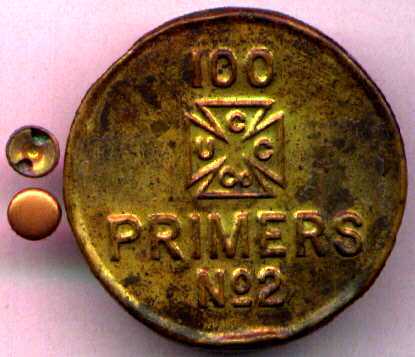 Brian Clark made
the point to me in an e-mail some time back that the Western Cartridge Company
boxes with the Maltese cross logo are very difficult to find in the centerfire
calibers. I would have to agree wholeheartedly, as I haven't had a lot of
luck finding them myself. The Maltese cross was originally the logo for the
Union Cap and Chemical Company, formed in 1900 by the Western Cartridge Company
and the Austin Cartridge Company, to produce primers for their shotgun shells.
Western and Austin were relatively small companies that purchased the components
for their shotgun shells from other makers. The Ammunition Manufacturers
Association, made up of Winchester Repeating Arms Company, Union Metallic
Cartridge Company, United States Cartridge Company, and Phoenix Metallic Brian Clark made
the point to me in an e-mail some time back that the Western Cartridge Company
boxes with the Maltese cross logo are very difficult to find in the centerfire
calibers. I would have to agree wholeheartedly, as I haven't had a lot of
luck finding them myself. The Maltese cross was originally the logo for the
Union Cap and Chemical Company, formed in 1900 by the Western Cartridge Company
and the Austin Cartridge Company, to produce primers for their shotgun shells.
Western and Austin were relatively small companies that purchased the components
for their shotgun shells from other makers. The Ammunition Manufacturers
Association, made up of Winchester Repeating Arms Company, Union Metallic
Cartridge Company, United States Cartridge Company, and Phoenix Metallic
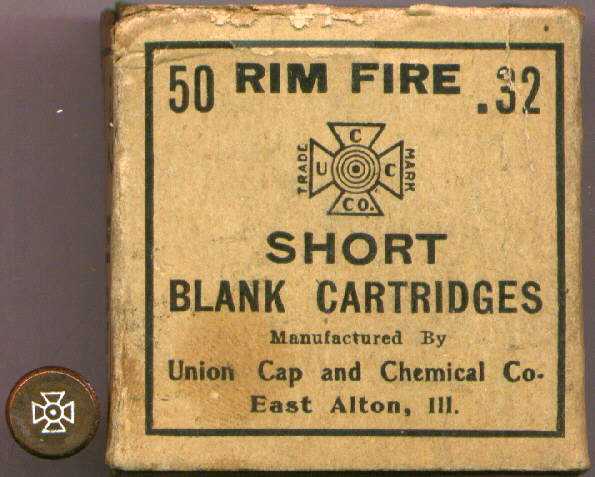 Cartridge
Company, had begun limiting the supplies of components to the small
producers in an effort to exercise more control over prices in the market.
As a result, the small companies had to find other sources or face going
out of business. At the time of the formation of the Union Cap & Chemical
Company, Western only produced shotgun shells, but around 1905 they began
producing .22 and .32 rimfire ammunition, which was sold through Union Cap
& Chemical with that company's label and the Maltese cross
headstamp. In 1908, Western bought out Austin Cartridge Company and
continued using the Maltese cross, minus the letters 'U C C Co' in the
four arms of the logo, on their rimfire ammunition, Cartridge
Company, had begun limiting the supplies of components to the small
producers in an effort to exercise more control over prices in the market.
As a result, the small companies had to find other sources or face going
out of business. At the time of the formation of the Union Cap & Chemical
Company, Western only produced shotgun shells, but around 1905 they began
producing .22 and .32 rimfire ammunition, which was sold through Union Cap
& Chemical with that company's label and the Maltese cross
headstamp. In 1908, Western bought out Austin Cartridge Company and
continued using the Maltese cross, minus the letters 'U C C Co' in the
four arms of the logo, on their rimfire ammunition,
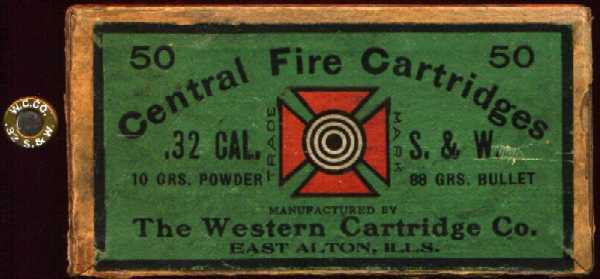 as well as
for the cartridge headstamps initially, followed very quickly by their familiar
diamond headstamp. They also soon began production of centerfire ammunition,
also with the Maltese cross logo on the label, most likely only in the most
common pistol calibers at the time. The headstamp on these early cartridges
was 'W.C.Co.' I have only been able to find these boxes in .32 S&W and
.38 S&W Special, both shown here. Note that the cartridges in the .32
box are loaded with 10 grains black powder; those in the .38 box are
smokeless, for which standard practice was not to show the powder as well as
for the cartridge headstamps initially, followed very quickly by their familiar
diamond headstamp. They also soon began production of centerfire ammunition,
also with the Maltese cross logo on the label, most likely only in the most
common pistol calibers at the time. The headstamp on these early cartridges
was 'W.C.Co.' I have only been able to find these boxes in .32 S&W and
.38 S&W Special, both shown here. Note that the cartridges in the .32
box are loaded with 10 grains black powder; those in the .38 box are
smokeless, for which standard practice was not to show the powder
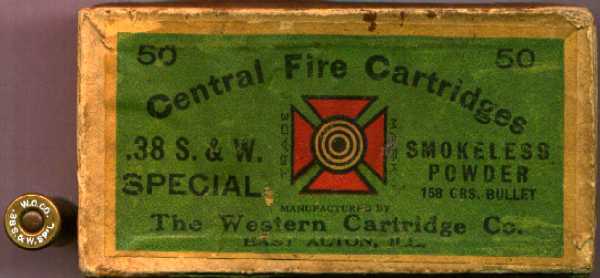 charge. I'm
certain they must have been made in .38 S&W Special also, but I haven't
been able to find that one yet. The diamond logo made its appearance on box
labels around 1910. The short (2 years or so) period of production would
account for the limited number of centerfire Maltese cross boxes found today.
It would be nice to see the Western product lists from 1909 and 1910 to get
a good idea of just how many calibers were produced in the Maltese cross
boxes. I'd appreciate it if anyone with other calibers in the Maltese cross
boxes would let me know what you have. An ironic twist to all this is that
the efforts charge. I'm
certain they must have been made in .38 S&W Special also, but I haven't
been able to find that one yet. The diamond logo made its appearance on box
labels around 1910. The short (2 years or so) period of production would
account for the limited number of centerfire Maltese cross boxes found today.
It would be nice to see the Western product lists from 1909 and 1910 to get
a good idea of just how many calibers were produced in the Maltese cross
boxes. I'd appreciate it if anyone with other calibers in the Maltese cross
boxes would let me know what you have. An ironic twist to all this is that
the efforts 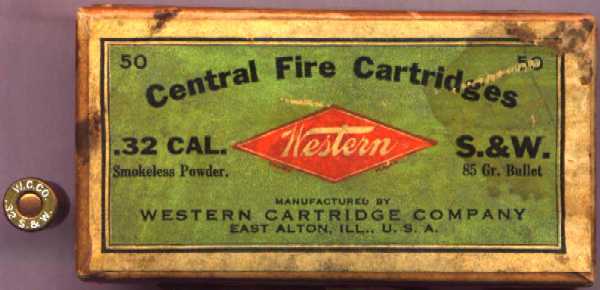 of
the Ammunition Manufacturers Association's efforts were partially responsible
for the Western Cartridge Company becoming a major player in the industry.
Of the four companies that formed the association, only UMC managed to remain
solvent, merging with Remington in 1912 to form Remington-UMC. Phoenix
experienced financial woes following the death of one of its founders, and
the assets were sold to UMC and Winchester in 1891, who continued producing
the Phoenix line of ammunition as the American Metallic Cartridge Company
until 1898. Following World War I, Winchester began experiencing financial
problems, which continued through the 1920s. The company went into receivership
in 1931, and, in what should be considered a classic example of 'just
deserts', was purchased by Western at the end of that year. of
the Ammunition Manufacturers Association's efforts were partially responsible
for the Western Cartridge Company becoming a major player in the industry.
Of the four companies that formed the association, only UMC managed to remain
solvent, merging with Remington in 1912 to form Remington-UMC. Phoenix
experienced financial woes following the death of one of its founders, and
the assets were sold to UMC and Winchester in 1891, who continued producing
the Phoenix line of ammunition as the American Metallic Cartridge Company
until 1898. Following World War I, Winchester began experiencing financial
problems, which continued through the 1920s. The company went into receivership
in 1931, and, in what should be considered a classic example of 'just
deserts', was purchased by Western at the end of that year.
A sealed box of 4mm Ubungsmunition M20
cartridges....

Here's another cartridge that is not too uncommon, but for which I have not
seen a box before. Apparently this stuff is still being manufactured, so
there must be plenty of boxes somewhere. This is a centerfire indoor target
practice cartridge, developed in 1921 by RWS, and intended for use with a
barrel insert that allows it to be adapted to pistols in most popular calibers.
The case has no powder, the bullet being propelled by the priming charge
only. There is a similar cartridge, the 4mm Ubungsmunition Geco, that has
the same case shape, but with an added rim. It was developed in 1920 by Gustav
Genschow & Co. It has been out of production for years and is quite scarce
in this country.
An early shotgun
shell.......
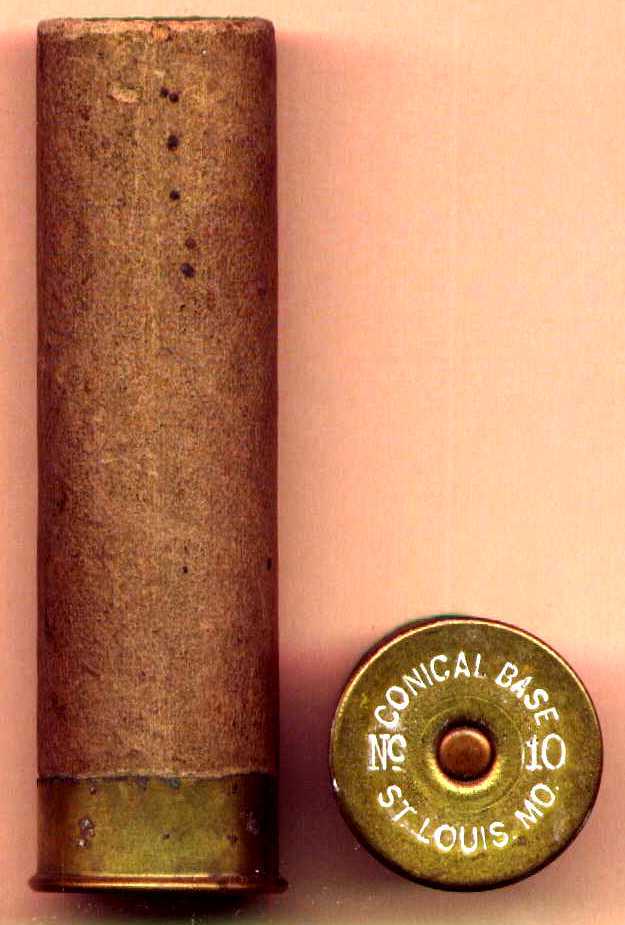
This is a 10 gauge 'conical base' shotgun shell, made by the Saint Louis
Patent Shell Manufacturing Company of Saint Louis, Missouri. The company
was incorporated in 1875, for the purpose of producing shotgun shells based
on the patent of David E. Williams. His patent #108,543 covered a shell with
a conical chamber in the base, formed of coiled paper and extending about
an inch up the inside of the shell. The advantages gained from this design,
according to the 1876 James Bown & Company advertisement shown below,
are that 'a large saving is effected in the quantity of powder required,
and the recoil is consequently much lessened'. Another obvious benefit would
be the strengthening of the hull where it meets the front edge of the brass
base. This coupled with the reduced loads would allow the shooter to
get more reloads out of a case before the hull began to separate from the
base. The Saint Louis Patent Shell Manufacturing Company went out of business
in 1881, due most likely to their inability to establish a niche in
a market dominated by the Winchester Repeating Arms Company and
the Union Metallic Cartridge Company. These shells sold for $1.50 per hundred
in10 gauge and $1.25 per hundred in12 gauge. Anyone run across a full box
or two of these anytime recently?

|



